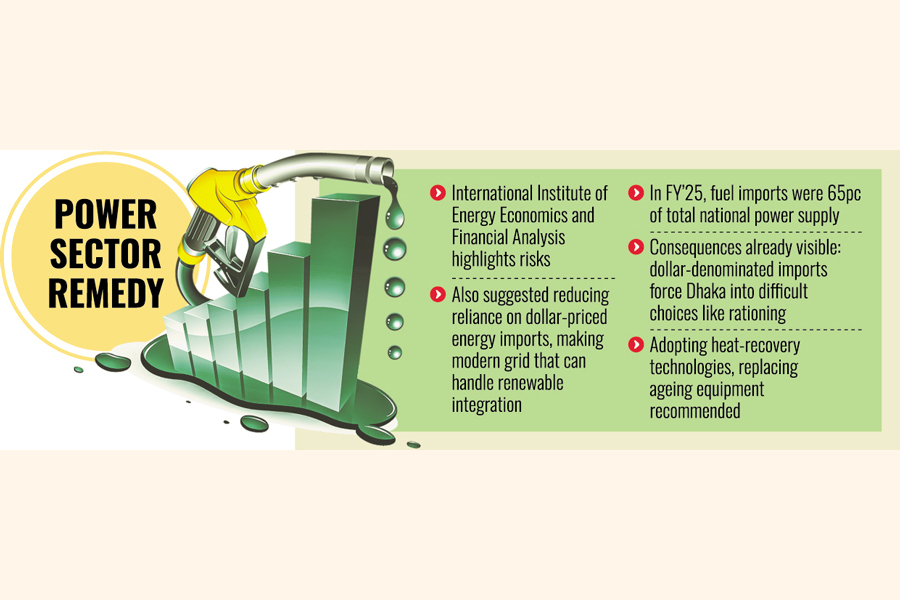
Published :
Updated :

Years of electricity-generation expansion falls short of catering Bangladesh's demand and its reliance on imported fossil fuels leaves the country susceptible to global price shocks and supply shortages, experts alert.
A new report by the Institute for Energy Economics and Financial Analysis (IEEFA) highlights how dependency on imported fuels has surged in recent years.
In the past fiscal year 2024-25, imports accounted for around 65 per cent of the nation's total power supply -- a mix of imported electricity and fuels used in domestic generation.
This marks a 63-percent rise in fossil-fuel dependence compared to 2019-20, far outpacing the 43-percent increase in overall power generation over the same period.
"The consequences are already visible. Dollar-denominated imports have forced Dhaka into difficult choices: rationing supply through ad-hoc load-shedding, or firing up costly oil-based plants to keep the grid stable. Meanwhile, some of the country's most efficient gas-fired facilities sit idle, starved of fuel," says Shafiqul Alam, Lead Analyst of the IEEFA.
According to the study, since 2012, industries across Bangladesh have invested heavily in their own captive power systems, seeking reliability as the national grid struggled to deliver.
"Some sectors have made major strides in efficiency, but many continue to operate outdated, wasteful generators."
The IEEFA estimates that industries could save as much as 50 billion cubic feet of imported liquefied natural gas (LNG) by adopting heat-recovery technologies and replacing ageing equipment.
But the rise of captive power has created a perverse effect: diverting precious gas away from efficient grid-connected plants. When supply is tight, these newer facilities are left underutilised, while industries burn more fuels in less efficient units.
The idle plants, in turn, attract higher "capacity payments" -- charges the government must pay operators even if their facilities are not generating electricity - driving up costs further. Extended shutdowns also risk damaging plant infrastructure, creating long-term technical headaches.
Analysts argue that Dhaka faces a stark choice. Either it enforces strict efficiency standards on captive generators or it strengthens the grid sufficiently to make them redundant as anything more than back-up.
The path it chooses will shape the resilience of its power sector as Bangladesh prepares to graduate from least-developed country status in November 2026, when it will face tougher international competition.
With power demand surging, the government has attempted to get ahead of looming crises.
Officials anticipated that peak consumption in the summer of 2025 could reach 18,000 megawatts, compared with 17,200MW in April 2024.
Measures were rolled out early: a February circular barred households from setting air conditioners below 25C, while the Sustainable and Renewable Energy Development Authority set new efficiency benchmarks for government offices.
Unseasonably heavy rains brought some relief, keeping cooling demand down. Peak load hit 17,099MW in July, slightly below last year's levels. Yet the reprieve proved short-lived.
In September, shortages of imported coal and gas triggered widespread load-shedding, with daily shortfalls averaging 404MW. At one point in late April, the deficit spiked to 2,353MW.
According to official data, between 31 August and 11 September the number of plants reporting gas shortages rose from 12 to 19. For households, that translated into abrupt blackouts. For industry, it meant lost output and mounting costs.
Bangladesh's experience underscores the dangers of tying energy security to volatile global fuel markets.
Policymakers and experts warn that unless Dhaka curbs wasteful consumption and diversifies its energy mix, the fragility will only deepen as economic activity rebounds and climate change drives up cooling demand.
"The country needs to build a power system that is not only bigger, but more resilient," the IEEFA report concludes.
"That means cutting inefficiencies, reducing reliance on dollar-denominated energy imports, and investing in a modern grid that can handle renewable integration."
mirmostafiz@yahoo.com


 For all latest news, follow The Financial Express Google News channel.
For all latest news, follow The Financial Express Google News channel.